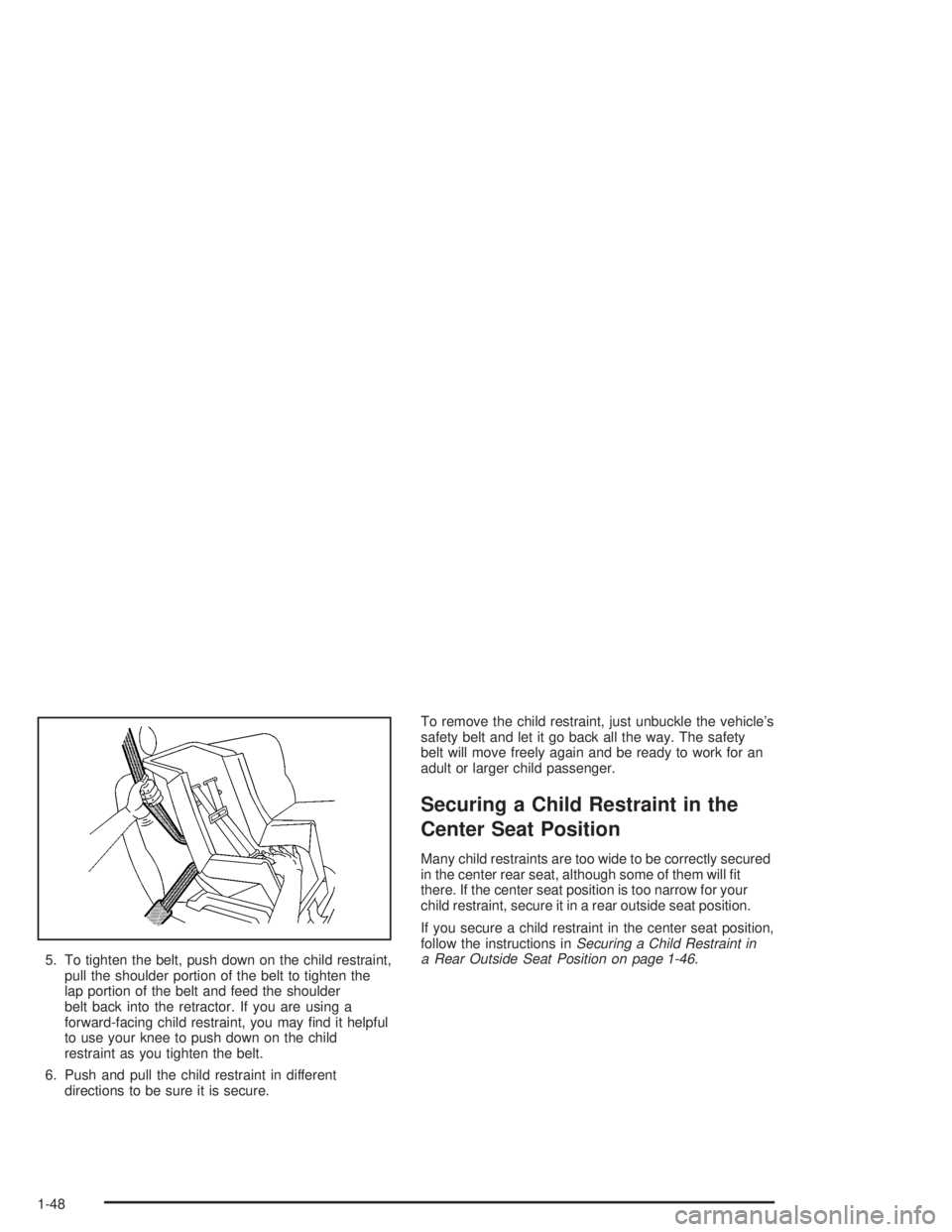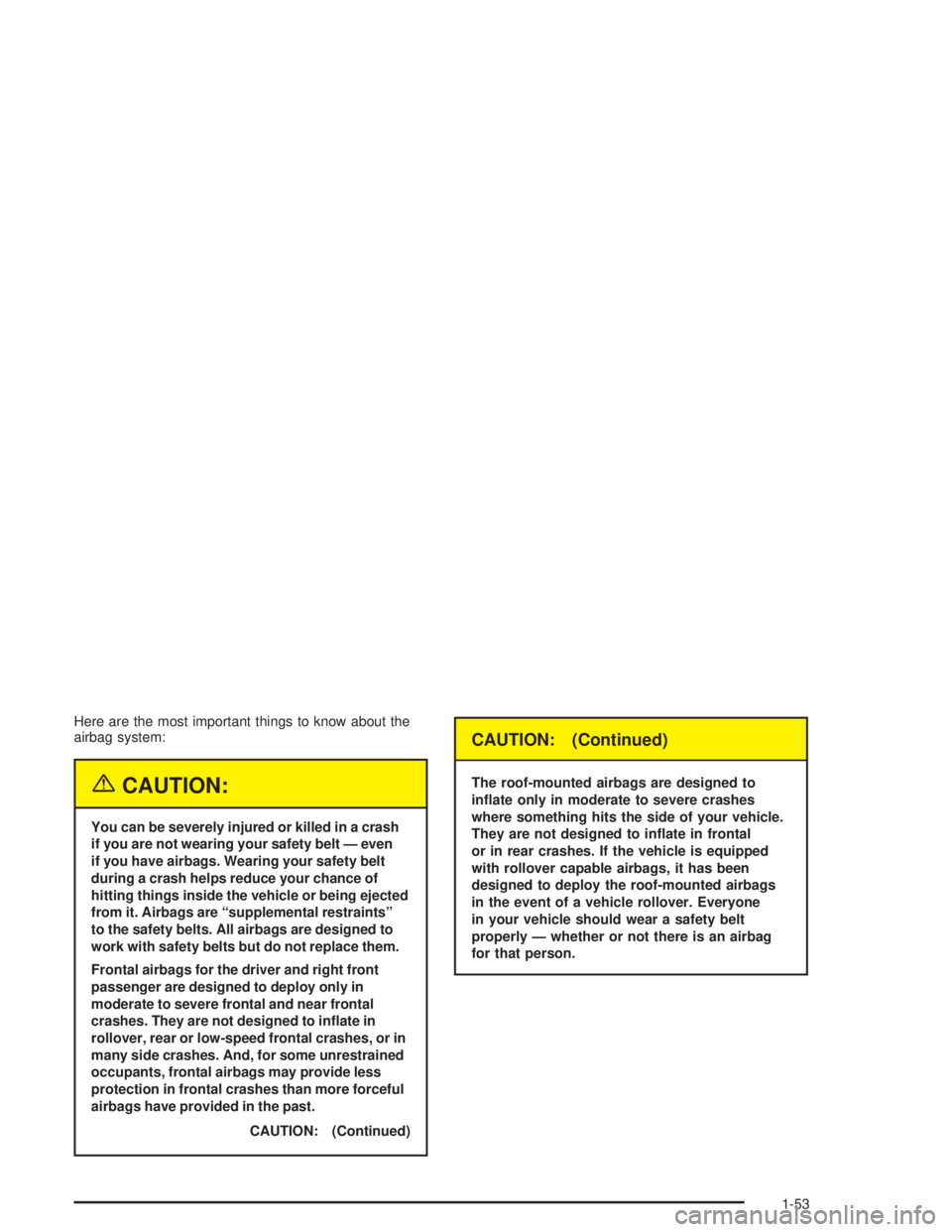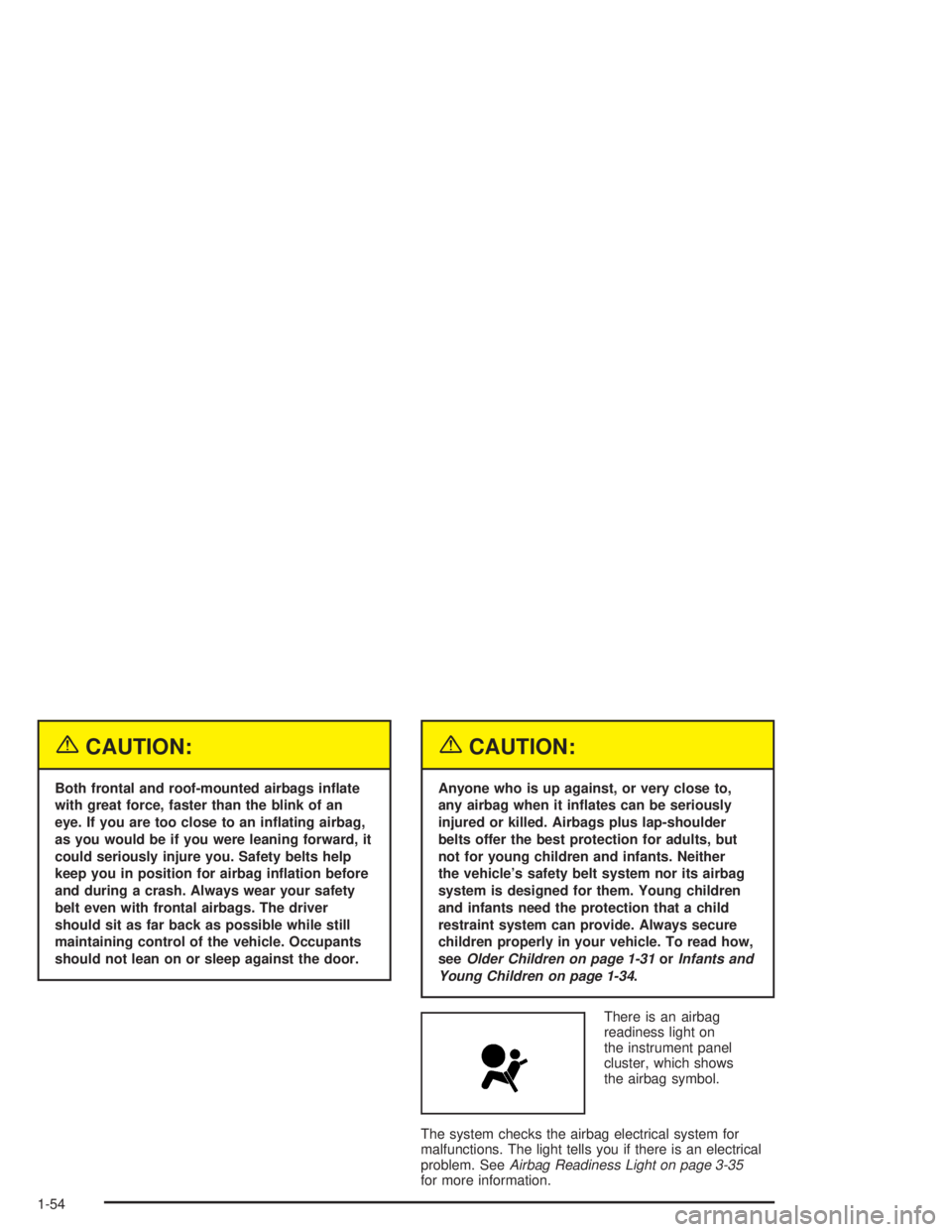Page 53 of 480
3. Buckle the belt. Make sure the release button is
positioned so you would be able to unbuckle the
safety belt quickly if you ever had to.4. Pull the rest of the shoulder belt all the way out of
the retractor to set the lock.
1-47
Page 54 of 480

5. To tighten the belt, push down on the child restraint,
pull the shoulder portion of the belt to tighten the
lap portion of the belt and feed the shoulder
belt back into the retractor. If you are using a
forward-facing child restraint, you may �nd it helpful
to use your knee to push down on the child
restraint as you tighten the belt.
6. Push and pull the child restraint in different
directions to be sure it is secure.To remove the child restraint, just unbuckle the vehicle’s
safety belt and let it go back all the way. The safety
belt will move freely again and be ready to work for an
adult or larger child passenger.
Securing a Child Restraint in the
Center Seat Position
Many child restraints are too wide to be correctly secured
in the center rear seat, although some of them will �t
there. If the center seat position is too narrow for your
child restraint, secure it in a rear outside seat position.
If you secure a child restraint in the center seat position,
follow the instructions inSecuring a Child Restraint in
a Rear Outside Seat Position on page 1-46.
1-48
Page 56 of 480

There is no top strap anchor at the right front seating
position. Do not secure a child seat in this position if a
national or local law requires that the top strap be
anchored or if the instructions that come with the child
restraint say that the top strap must be anchored. See
Top Strap on page 1-41if your child restraint has one.
You will be using the lap-shoulder belt to secure the child
restraint in this position. Be sure to follow the instructions
that came with the child restraint. Secure the child in the
child restraint when and as the instructions say.
1. Your vehicle has a right front passenger’s frontal
airbag. SeePassenger Sensing System on
page 1-62. General Motors recommends that
rear-facing child restraints be secured in a rear seat,
even if the airbag is off. If your child restraint is
forward-facing, move the seat as far back as it will
go before securing the child restraint in this
seat. SeePower Seats on page 1-4.
When the passenger sensing system has turned off
the right front passenger’s frontal airbag, the off
indicator in the passenger airbag status indicator
should light and stay lit when you turn the ignition to
RUN or START. SeePassenger Airbag Status
Indicator on page 3-36.2. Put the child restraint on the seat.
3. Pick up the latch plate, and run the lap and shoulder
portions of the vehicle’s safety belt through or
around the restraint. The child restraint instructions
will show you how.
4. Buckle the belt. Make sure the release button is
positioned so you would be able to unbuckle the
safety belt quickly if you ever had to.
1-50
Page 57 of 480
5. Pull the rest of the shoulder belt all the way out of
the retractor to set the lock.6. To tighten the belt, push down on the child
restraint, pull the shoulder portion of the belt
to tighten the lap portion of the belt and feed the
shoulder belt back into the retractor. If you are
using a forward-facing child restraint, you may �nd
it helpful to use your knee to push down on the
child restraint as you tighten the belt. You should
not be able to pull more of the belt from the retractor
once the lock has been set.
1-51
Page 58 of 480

7. Push and pull the child restraint in different
directions to be sure it is secure.
8. If the airbag is off, the off indicator in the inside
rearview mirror will be lit and stay lit when the
key is turned to RUN or START.
If a child restraint has been installed and the on
indicator is lit, turn the vehicle off. Remove the child
restraint from the vehicle and reinstall the child restraint.
If after reinstalling the child restraint and restarting
the vehicle, the on indicator is still lit, check to make
sure that the vehicle’s seatback is not pressing the child
restraint into the seat cushion. If this happens, slightly
recline the vehicle’s seatback and adjust the seat
cushion if possible. Also make sure the child restraint is
not trapped under the vehicle head restraint. If this
happens, adjust the head restraint.
If the on indicator is still lit, secure the child in the child
restraint in a rear seat position in the vehicle and
check with your dealer.
To remove the child restraint, just unbuckle the vehicle’s
safety belt and let it go back all the way. The safety
belt will move freely again and be ready to work for an
adult or larger child passenger.Airbag System
Your vehicle has a frontal airbag for the driver and
another frontal airbag for the right front passenger.
Your vehicle may also have roof-mounted airbags
designed for either side impact or rollover deployment.
Roof-mounted airbags are available for the driver
and the passenger seated directly behind the driver
and for the right front passenger and the passenger
seated directly behind that passenger.
If your vehicle has roof-mounted airbags, the words
AIR BAG will appear on the airbag covering on
the sidewall trim near the driver’s and right front
passenger’s window.
Frontal airbags are designed to help reduce the risk
of injury from the force of an in�ating frontal airbag.
But these airbags must in�ate very quickly to do their
job and comply with federal regulations.
1-52
Page 59 of 480

Here are the most important things to know about the
airbag system:
{CAUTION:
You can be severely injured or killed in a crash
if you are not wearing your safety belt — even
if you have airbags. Wearing your safety belt
during a crash helps reduce your chance of
hitting things inside the vehicle or being ejected
from it. Airbags are “supplemental restraints”
to the safety belts. All airbags are designed to
work with safety belts but do not replace them.
Frontal airbags for the driver and right front
passenger are designed to deploy only in
moderate to severe frontal and near frontal
crashes. They are not designed to in�ate in
rollover, rear or low-speed frontal crashes, or in
many side crashes. And, for some unrestrained
occupants, frontal airbags may provide less
protection in frontal crashes than more forceful
airbags have provided in the past.
CAUTION: (Continued)
CAUTION: (Continued)
The roof-mounted airbags are designed to
in�ate only in moderate to severe crashes
where something hits the side of your vehicle.
They are not designed to in�ate in frontal
or in rear crashes. If the vehicle is equipped
with rollover capable airbags, it has been
designed to deploy the roof-mounted airbags
in the event of a vehicle rollover. Everyone
in your vehicle should wear a safety belt
properly — whether or not there is an airbag
for that person.
1-53
Page 60 of 480

{CAUTION:
Both frontal and roof-mounted airbags in�ate
with great force, faster than the blink of an
eye. If you are too close to an in�ating airbag,
as you would be if you were leaning forward, it
could seriously injure you. Safety belts help
keep you in position for airbag in�ation before
and during a crash. Always wear your safety
belt even with frontal airbags. The driver
should sit as far back as possible while still
maintaining control of the vehicle. Occupants
should not lean on or sleep against the door.
{CAUTION:
Anyone who is up against, or very close to,
any airbag when it in�ates can be seriously
injured or killed. Airbags plus lap-shoulder
belts offer the best protection for adults, but
not for young children and infants. Neither
the vehicle’s safety belt system nor its airbag
system is designed for them. Young children
and infants need the protection that a child
restraint system can provide. Always secure
children properly in your vehicle. To read how,
seeOlder Children on page 1-31orInfants and
Young Children on page 1-34.
There is an airbag
readiness light on
the instrument panel
cluster, which shows
the airbag symbol.
The system checks the airbag electrical system for
malfunctions. The light tells you if there is an electrical
problem. SeeAirbag Readiness Light on page 3-35
for more information.
1-54
Page 65 of 480

The airbag system is designed to work properly under
a wide range of conditions, including off-road usage.
Observe safe driving speeds, especially on rough
terrain. As always, wear your safety belt. SeeOff-Road
Driving with Your Four-Wheel-Drive Vehicle on
page 4-15for tips on off-road driving.
What Makes an Airbag In�ate?
In an impact of sufficient severity, the airbag sensing
system detects that the vehicle is in a crash. In the
case of a “rollover capable” roof-mounted airbag, the
sensing system detects that the vehicle is about to
roll over. For both frontal and roof-mounted airbags,
the sensing system triggers a release of gas from the
in�ator, which in�ates the airbag. The in�ator, airbag,
and related hardware are all part of the airbag modules
inside the steering wheel and in the instrument panel
in front of the right front passenger. For vehicles
with roof-mounted airbags, the airbag modules are
located in the ceiling of the vehicle, near the side
windows.
How Does an Airbag Restrain?
In moderate to severe frontal or near frontal collisions,
even belted occupants can contact the steering wheel
or the instrument panel. In moderate to severe side
collisions, even belted occupants can contact the inside
of the vehicle. The airbag supplements the protection
provided by safety belts. Airbags distribute the force of
the impact more evenly over the occupant’s upper
body, stopping the occupant more gradually. But the
frontal airbags would not help you in many types
of collisions, including rollovers, rear impacts, and
many side impacts, primarily because an occupant’s
motion is not toward the airbag. Roof-mounted airbags
would not help you in many types of collisions,
including frontal or near frontal collisions, and rear
impacts, primarily because an occupant’s motion is
not toward those airbags. Airbags should never
be regarded as anything more than a supplement to
safety belts, and then only in moderate to severe frontal
or near-frontal collisions for the driver’s and right front
passenger’s frontal airbags, and only in moderate
to severe side collisions or rollovers for the roof-mounted
airbags.
1-59